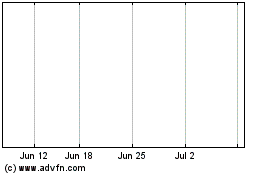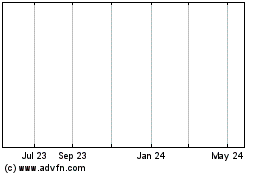U.S. 10-Year Note Yield Dips Below 2%
August 24 2015 - 3:15PM
Dow Jones News
A deepening rout in global stocks and commodities sent investors
piling into the safe harbor of U.S. government bonds Monday,
sending the yield on the benchmark 10-year note below 2% for the
first time since April.
The flight for safety has been gathering speed over the past few
weeks, underscoring growing anxiety over China's slowing economy
and its stock market rout, which has rippled through markets
globally and clouded the global economic outlook.
The uncertainty over whether the Federal Reserve will raise
interest rates next month or wait longer to act has contributed to
growing volatility in riskier assets, driving many to shed their
risk appetites and shift focus to preserve capital.
"This is a flight to quality and the actual level that the
Treasury yield achieves in this environment is not meaningful,"
said David Keeble, global head of fixed-income strategy at Cré dit
Agricole. "This is a time when you dig a deep hole, close your eyes
and put your fingers in your ears."
On Monday, U.S. stocks and European equities fell sharply as a
rout in Chinese shares accelerated, wiping out gains for the year.
U.S. oil prices tumbled over 4% and fell further below $40 a
barrel. As investors sought shelter in Treasury debt, the yield on
the benchmark 10-year Treasury note fell to as low as 1.905%, the
lowest intraday level since April 22, according to Tradeweb.
In recent trading, the haven buying has been easing as U.S.
stocks pared their losses. The yield, a foundation for global
finance and a key indicator of investors' sentiment toward growth
and inflation, was 2.026%, still down from 2.052% Friday. Yields
fall as prices rise.
Growing turmoil is heaping pressure on global central banks to
act. If policy makers take action to soothe investors' fears about
markets and growth, demand for haven assets could wane, sending
yields higher, say some traders. On Sunday, The Wall Street Journal
reported that China's central bank is preparing to bolster
liquidity in the country's banking system.
Over the past two months, anxiety has been growing over the
global economy amid lower commodity prices, plunging
emerging-market assets and a selloff in both stocks and bonds sold
by lower-rated U.S. companies, known as junk bonds.
China's surprising move to devalue the yuan earlier this month
amid tumbling exports heightened concerns over the pace of the
world's second-largest economy, which has been a big buyer of
commodities, including iron ore, copper and oil. Last Friday, a
report showed a gauge of China's manufacturing sector dropped to
its lowest level in 6 1/2 years.
The financial markets are complicating the Fed's plan to raise
interest rates for the first time since 2006. The U.S. economy has
been strengthening after a soft patch earlier this year. Solid jobs
growth has bolstered the case for the Fed to start moving away from
crisis-era monetary stimulus. The Fed's ultraloose monetary policy
has boosted prices of a wide range of financial assets over the
past years and now investors are concerned whether these assets may
fall in value once the Fed shifts gears into a tightening mode.
The nonfarm jobs report for August is due to be released in
early September. Analysts say a strong report may allow the central
bank to act at its Sept. 16-17 policy meeting. Yet many investors
say global uncertainties and rising volatility in many asset
markets could make the Fed wait longer to act. They are concerned
that a rate increase could jolt sentiment and roil already jumpy
markets.
Fed-funds futures, used by investors and traders to place bets
on central bank policy, showed Monday that investors and traders
see a 28% likelihood of a rate increase at the September 2015
meeting, according to data from the CME Group. A couple of weeks
ago, the odds were around 50%.
"There are fears that global growth is going to come crashing
down," said Thomas Roth, executive director in the U.S. government
bond trading group at Mitsubishi UFJ Securities (USA) Inc. in New
York. "A week ago we were thinking the U.S. economy was strong
enough for a Fed rate hike and now we fear a global recession. It
is amazing how quickly things can change."
As expectations on the Fed to tighten next month pulled back,
the yield on the two-year Treasury note fell to 0.560% Monday from
0.629% Friday. The yield is highly sensitive to changes in the
Fed's interest rate policy outlook.
Yields on long-term bonds such as the 10-year notes and 30-year
bonds are more sensitive to changes in global growth and inflation
outlook. Inflation chips away bonds' fixed return over time and it
is a main threat to long-term bonds.
The Fed is also grappling with the fallout from plunging
crude-oil prices—U.S. crude oil prices dropped nearly 6% Monday.
While lower energy prices are a boon for U.S. consumers, they have
reduced inflation expectations, which makes it more difficult for
the Fed to meet its 2% target.
The break-even rate, or the differential between the benchmark
10-year Treasury note and the 10-year Treasury inflation protected
security, was 1.49 percentage points Friday, the lowest level since
2009.
The level suggests that investors expect the U.S. inflation rate
to be running at an annualized 1.49% on average within a decade. A
month ago, the reading was above 1.8%.
Write to Min Zeng at min.zeng@wsj.com
Subscribe to WSJ: http://online.wsj.com?mod=djnwires
(END) Dow Jones Newswires
August 24, 2015 15:00 ET (19:00 GMT)
Copyright (c) 2015 Dow Jones & Company, Inc.
Treasury Group Ltd (ASX:TRG)
Historical Stock Chart
From Mar 2024 to Apr 2024

Treasury Group Ltd (ASX:TRG)
Historical Stock Chart
From Apr 2023 to Apr 2024
